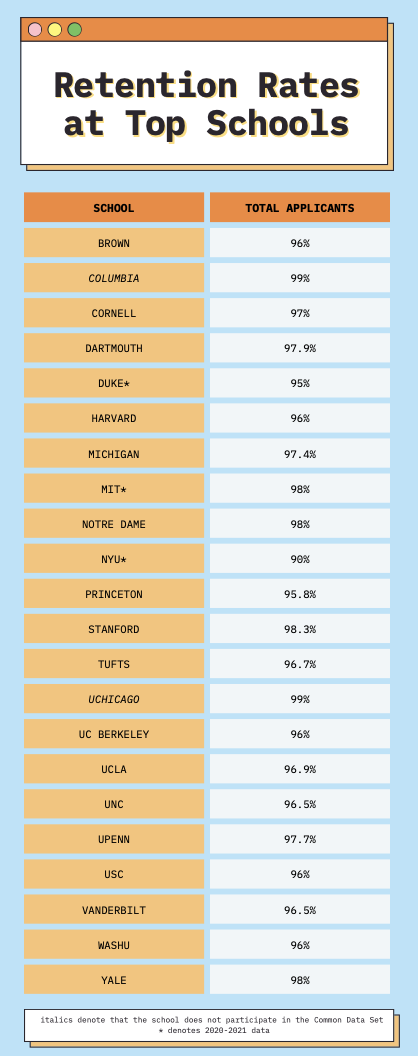If you’re looking at colleges for the fall, whether as a first-year student or a transfer, you should be concerned with a college’s retention rate. The retention rate is the percentage of freshmen who come back for their sophomore year, and it can tell you a lot more than just the amount of freshmen who stick around. It’s an extremely helpful tool in building your college list, no matter how you’re applying.
If you’re applying as a freshman, this number could be used as a very loose indicator of campus satisfaction. A school with a low retention rate could have a slew of issues that make people want to leave, and a school with a high retention rate means they’re probably doing something right. Selective colleges tend to have higher retention rates, in the high 90s, while the average sits around 75%. However, if you’re looking for some kind of “happiness quotient,” this number isn’t going to be a perfect indicator. We recommend searching campus newspapers, blogs, even *shudder* Reddit to see how kids feel about the school, but as always, take it with a grain of salt. Upset people are louder than content people.
Now let’s talk about who benefits from retention rate data the most: the transfer student. Retention rates don’t just tell you how many students stayed. They also tell you how many have left, which in turn tells you how many spots are available for you to vie for. We went through the most popular colleges with our applicants, dug through their data, and found their retention rates.
Most of the raw data we want from colleges is hard to find. Things like transfer acceptance rates, for example. However, most of colleges our clients apply to are proud of their high retention rates, so these numbers are easy to find. To double check, we accessed their Common Data Sets to see the official retention rate they report. Columbia and UChicago both don’t fill out the CDS, but they both include retention rates in their self-released data. Funny that they’re both 99%. Not funny ha-ha. Funny weird. And especially suspicious for Columbia. (Are we making TikTok references? Yes.)
So let’s decode what this means. Most of these schools have retention rates above 95%, with the biggest outlier being NYU at 90%. It’s easy to say “Well 10% of students must hate NYU,” but some of that also has to do with the fact that it’s the largest private university in the US and also a school that many people attend before shooting their shot at higher ranked schools. This is also the same as the University of Central Florida’s retention rate – and they’re the largest public university in the US. We’re chalking this one up to size.
Let’s take two schools with similar retention rates but differing class sizes, like Brown and Berkeley. They both have retention rates of 96%, but Brown had a freshman class size of 1,705 while Berkeley had a freshman class size of 6,931. So if we do some basic math (we’re not really STEM people but we’ll try), that means the 4% of Brown students who left equaled 65 students, but at Berkeley that number is 278. In terms of transferring, that’s a lot.
Now you might be saying, but hold on a minute, Berkeley enrolled over 2,000 transfer students last year. How can that be right? Well, retention rate only applies to freshman to sophomore, not every other year. It doesn’t count for sophomores who leave, juniors who drop out of college, or seniors who are on their 3rd senior year. Even the Common Data Set doesn’t use 4-year graduation rates, only 6-year. Berkeley is also part of the UC system, which means transferring from UC to UC is a little easier. Also, not included in the retention rate is “death, permanent disability, service in the armed forces, foreign aid service of the federal government or official church missions.” But as for spots in their rising sophomore class? You know you’ve got at least 278.
At the very least, it’s good to arm yourself with this data. When you’re looking up schools, it’s beneficial to know everything you can to help you determine what will be the best fit. Things like retention rate, average class size, student-to-faculty ratio, core requirements, etc., will all give you the best insight into which schools have what you want.
If you want to apply to a top-tier school, it helps to have some help. We’re experts in the application process, both for first-year students and transfers, and we can help you with every part of the process – the Common App, the essays, the supplements, the research, interviews, everything.
Reach out to us today if you think you’d benefit from a college counselor.
